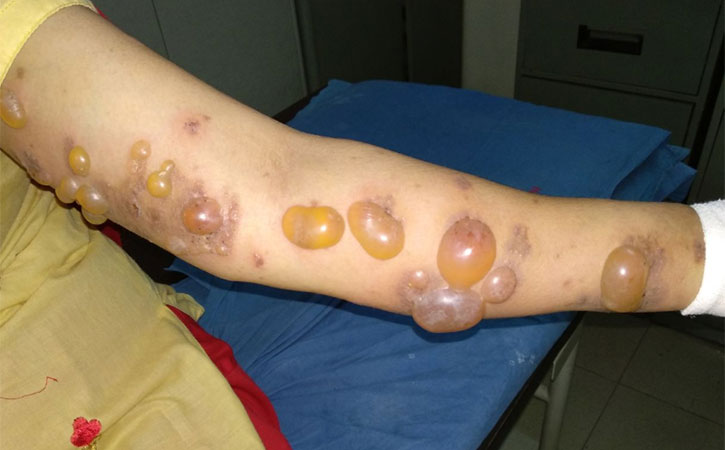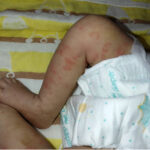Cicatricial pemphigoid, also known as benign mucous membrane pemphigoid (BMMP), is a rare autoimmune disease characterized by chronic blistering and scarring of the skin and mucous membranes. It is considered a form of pemphigoid, a group of subepidermal blistering disorders. Although it primarily affects older adults, Its can develop at any age and typically manifests with lesions that cause significant discomfort and disfigurement. This article delves into the clinical features, diagnostic approaches, and current treatment options for cicatricial pemphigoid, aiming to offer a comprehensive resource for both patients and healthcare professionals.

What is Cicatricial Pemphigoid?
Cicatricial pemphigoid is a rare chronic blistering disease that predominantly affects mucosal surfaces, such as the mouth, eyes, throat, and genital areas, although skin involvement may also occur. The hallmark of this condition is the formation of tense blisters, which can rupture and lead to painful erosions and ulcers. As the disease progresses, the affected tissues often scar, particularly in areas such as the conjunctiva (the membrane covering the eye), which may lead to permanent damage and vision loss.
Pathophysiology of Cicatricial Pemphigoid
Its classified as an autoimmune disorder, where the body’s immune system mistakenly attacks healthy tissues. Specifically, the body produces antibodies against proteins that help bind the skin to underlying tissues, such as the basement membrane zone. This leads to a separation of the epidermis from the dermis, causing blister formation. Over time, scarring can occur, particularly in mucous membranes, leading to fibrosis and permanent tissue damage.
Symptoms
The symptoms of cicatricial pemphigoid vary based on the severity and location of the lesions. Common symptoms include:
1. Blistering and Erosions
- Tense, fluid-filled blisters form on the skin or mucous membranes. These blisters are often painful and may rupture easily, leading to erosions and ulcers.
2. Mucosal Involvement
- The oral mucosa is frequently affected, leading to painful ulcers in the mouth, difficulty swallowing, and potential loss of teeth.
- The eyes are commonly involved, causing redness, pain, and potential vision loss if left untreated.
- Genital and anal regions may also develop blisters and ulcers, contributing to significant discomfort.
3. Scarring
- Over time, blisters and ulcers heal with scarring, particularly in areas such as the eyes and mouth, leading to permanent damage.
- Ocular involvement can result in conjunctival scarring, which may cause eyelid deformities, symblepharon (adhesion between the eyelid and eyeball), and blindness if not managed appropriately.
4. Other Symptoms
- Some individuals may experience generalized symptoms such as fever, weight loss, and malaise during disease flare-ups.
Diagnosis
Early diagnosis of cicatricial pemphigoid is crucial to prevent irreversible tissue damage. The diagnostic process typically involves the following steps:
1. Clinical Evaluation
- A thorough examination of the skin and mucous membranes is performed to assess the characteristic appearance of blisters and erosions. The involvement of multiple mucosal sites may raise suspicion of cicatricial pemphigoid.
2. Skin Biopsy
- A skin biopsy is often performed to confirm the diagnosis. Histopathological examination reveals subepidermal blistering and inflammatory infiltrates, typically including neutrophils and eosinophils.
3. Direct Immunofluorescence
- Direct immunofluorescence of a skin biopsy sample can help identify the presence of specific autoantibodies that target components of the basement membrane zone.
4. Serological Testing
- Blood tests may be conducted to detect circulating antibodies against the components of the basement membrane zone, such as BP180 and BP230, which are commonly implicated.
5. Ocular Testing
- Given the high frequency of ocular involvement, specialized tests like slit-lamp examination and conjunctival biopsy may be performed to assess the extent of eye damage.
Treatment of Cicatricial Pemphigoid
The management of cicatricial pemphigoid aims to control symptoms, reduce inflammation, and prevent scarring and long-term damage. Treatment is typically individualized based on the severity of the disease and the specific areas affected.
1. Topical Steroids
- For localized lesions, topical corticosteroids may be prescribed to reduce inflammation and prevent blister formation. These are often the first line of treatment for milder cases.
2. Systemic Corticosteroids
- In cases where the disease affects larger areas of the skin or mucous membranes, oral or intravenous corticosteroids may be required to control the immune response.
3. Immunosuppressive Medications
- In patients with moderate to severe cicatricial pemphigoid, medications that suppress the immune system, such as azathioprine, mycophenolate mofetil, or methotrexate, may be used in conjunction with corticosteroids.
4. Rituximab
- Rituximab, a monoclonal antibody that targets CD20+ B cells, has shown promise in treating autoimmune blistering diseases, including cicatricial pemphigoid. It is often considered for patients who do not respond to conventional therapies.
5. Tetracyclines
- Doxycycline or tetracycline may be used to manage the inflammatory component of the disease and to reduce scarring, particularly in ocular cicatricial pemphigoid.
6. Surgical Interventions
- In cases where scarring leads to functional impairments, such as in the eyes or mouth, surgical interventions may be necessary to correct deformities or prevent complications. This may include surgical reconstruction of the eyelids or skin grafting.
Complications of Cicatricial Pemphigoid
If left untreated or inadequately managed, cicatricial pemphigoid can lead to severe complications:
- Ocular Complications: The most serious complication is blindness due to conjunctival scarring, which may lead to symblepharon and corneal damage.
- Oral and Genital Complications: Chronic scarring of the mucous membranes in the mouth and genital areas can lead to functional issues such as difficulty eating, swallowing, or urinating.
Prognosis of Cicatricial Pemphigoid
The prognosis of cicatricial pemphigoid varies depending on the severity of the disease and the success of treatment. With prompt diagnosis and aggressive management, many patients experience periods of remission and can lead a relatively normal life. However, if left untreated, cicatricial pemphigoid can cause significant morbidity and long-term disability, particularly due to the risk of scarring and blindness.
Preventing Cicatricial Pemphigoid Flare-ups
Although cicatricial pemphigoid cannot be cured, the following strategies may help prevent flare-ups and minimize disease progression:
- Regular follow-ups with a dermatologist or rheumatologist to monitor the disease.
- Early intervention with appropriate treatments at the onset of flare-ups.
- Protection of mucosal surfaces, especially the eyes, to prevent irritation and injury.
- Patient education on recognizing early symptoms and seeking medical attention promptly.

